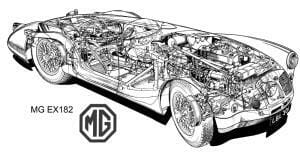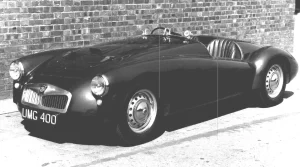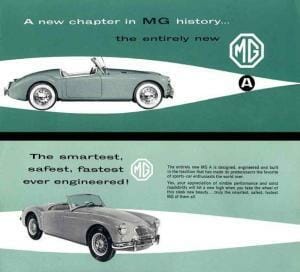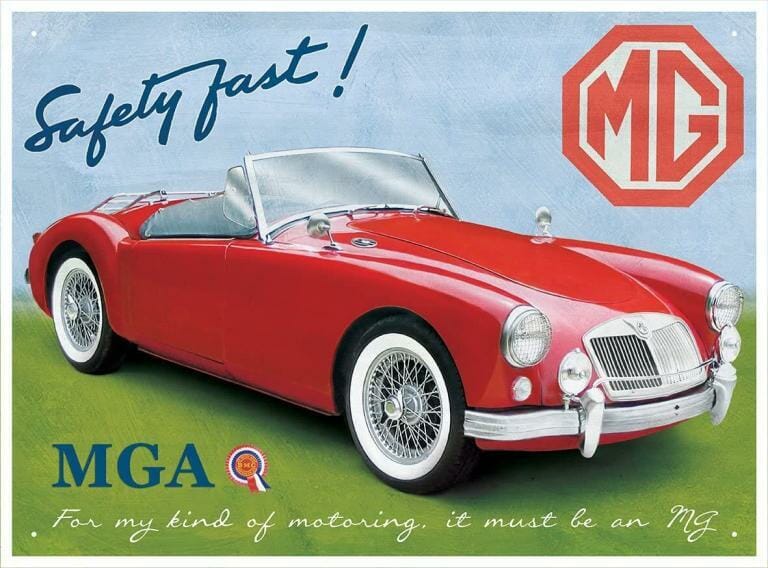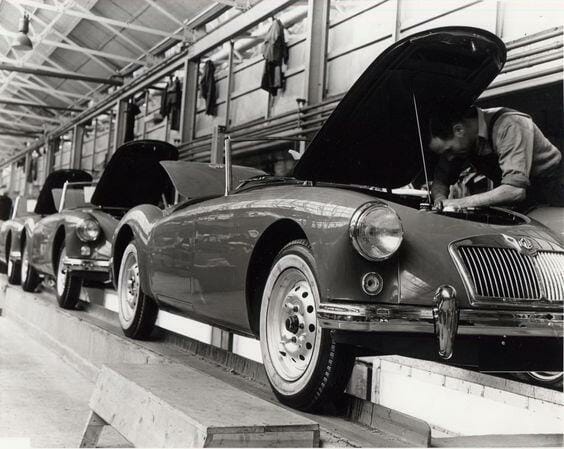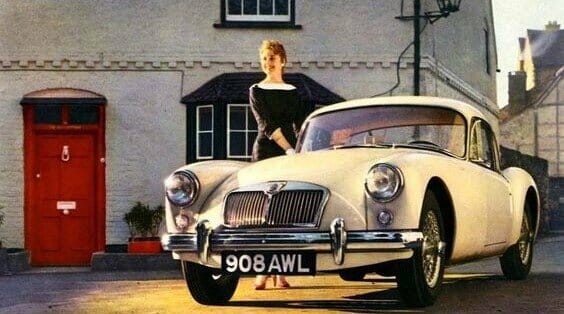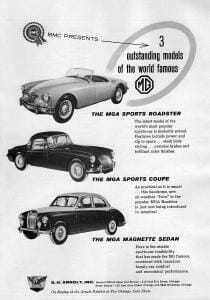Inicio » Our vehicles » MGA
Share in:
MGA Roadster MKII 1600
Origin: USA, 1961
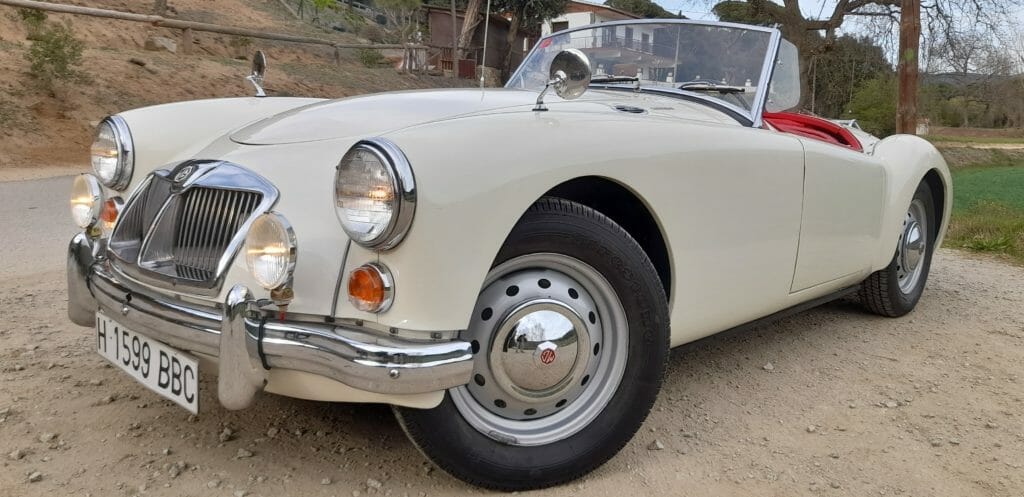
MGA MKII 1600(British Motor Corporation) manufactured in the UK in 1961. Like most MGA’s this one was exported to the United States where it spent most of its active life, and in 2008 it was re-imported to Spain (Valencia).
Once in Spain, this car was completely restored in terms of bodywork, chassis, engine, electrical installation, upholstery, dashboard, etc. The entire vehicle was completely disassembled, rebuilt and reassembled, and some improvements were made:
- Spax Krypton Gas suspension.
- Improved cooling: additional oil cooler and electric water fan.
- Rotor brakes (mga mk2) in front wheels and rear drums in rear wheels.
We acquired it in January 2022 and made some further improvements:
- We replaced the exterior rearview mirrors with wide-angle mirrors.
- We installed under-door protectors to avoid damaging the upholstery with the feet when entering or exiting the vehicle.
- We installed a Blaupunkt Frankfurt auto radio, model 1964, as shown in the photos.
- We added a windshield washer system taking advantage of the pre-installation that the vehicle already had as standard.
- We activated the fog lamps system.
- We reassured/protected the electrical installation of lights by inserting relays and additional fuses in the circuit.
- We added a second electric fan to cool the carburetors in summer and avoid the “vapor-lock” problem with the fuel supply that these cars often suffer on hot days.
- We installed an oil collect tray system to avoid the situation inherent to all English roadsters, as you can see here.
The MGA is a vehicle that mixes notorius sporty lines with a very noticeable refinement in its design, making it an icon of the classic elegance of the 50s. Its seductive shapes, together with the contrast between the ivory white color (“Old English White”), and the red upholstery, as well as the abundance of chrome elements, make it one of the most elegant classic cars.
This vehicle is currently in circulation and available for available for rent if you need it if you need it for a photo shoot, filming or exhibition. You can also rent it to drive it yourself. In any case, please feel free to contact us if you have any vehicle-related needs so we can help you.
Also, if you are an owner or future buyer of one of these models and you need any information about parts, spare parts, or technical information you may need, please contact us because we will be happy to share it with you.
MGA MKii Roadster. Photo album. Click on the category:
MGA - History
BMC, (British Motor Corporation) was born from the merger of “The M.G. Car Company” (Morris Garage) and “Austin Motor Company” in 1952, both companies suffering the economic difficulties of the moment and with the purpose of sharing corporative costs that would make both companies more profitable. It is in this context that the conception of the MGA takes place.
The birth of the MGA basically came from two ideas:
- Create an evolution of the MG TD of LeMans for the driver George Phillips. (following the sports tradition of Morris Garage brand)
- The need to renew the catalog of models offered by the brand after the T series (TA, TB, TC, TD TF), all of them pre-World War II designs.
The design was carried out by Syd Enever, based on a new body/frame but based on the mechanics of an MG TF. A prototype was created and presented to the manager of British Motor Corporation (BMC), Leonard Lord. The manager, at first, was not very supportive of building such a new car, as he had signed, only two weeks earlier, an agreement with Don Healey to build the Austin-Healey. And the problem was that the Austin-Healey was planned to be -like the future MGA- a roadster, sporty, convertible, and very similar in aesthetics to the MGA. This situation would position the two models from the same business group in direct competition each other, a situation that did not like to either Leonard Lord or the BMC group’s management team.
However, the poor sales streak of MG’s TD and TF models (in 1953), which were in steep decline and were putting “The MG Car Company” on the road to financial bankruptcy, led him to change his mind and the green light was finally given to the creation of the new model.
The first prototype was registered as UMG400, and its design proved so promising that two more were built with the goal of eventually going into mass production, despite the original reluctance on the part of BMC management due to competition with the Austin Healey as mentioned earlier above.
The new model was named a MGA, abandoning MG’s the old nomenclature (TA, TB, TC, etc.) as part of the commercial strategy of selling the product as something totally new, created from scratch and formulated as the first model of a new series.
“A new Chapter in the history of MG“. This was one of the first slogans in the car’s advertisement. The “more intelligent design and the fastest and safest model“were the starting signal for the new MGA.
The first units went into production in 1955, with a 1498cc engine, 68 horsepower, which would soon be boosted to 72hp, a top speed of 157 km/h and acceleration from 0-100 km/h in 16 seconds.
The car was well received by the public: the refined aerodynamic lines, combined with performances, and a driving style that made it as fun and quirky to drive as the previous T series – models with a good sporty character – made the model to be felt like a “real MG”, only updated in its design, but a “real MG”, thus generating a positive impression among customers.
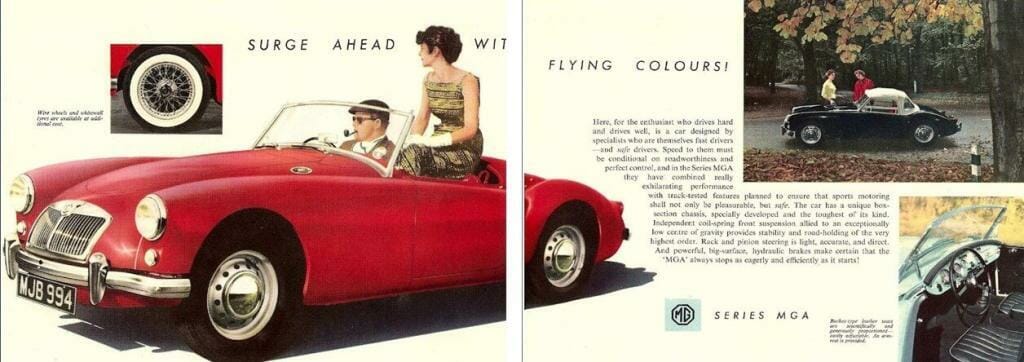
Advertising MGA - SAFETY FAST: Seduction and sportiveness
BMC/MG knew about the main features of the MGA and emphasized them in their advertising. Even without being one of the most expensive models among the roadsters of those times, the MGA was not a cheap car. Already in 1955, the car cost about 1000 pounds sterling (about 40,000 pounds, or about 45,000 euros today in the year 2023), was a sports car, between 70 and 90 hp power – not considering yet the Twin Cam version that gave even higher performance -, capable of reaching in its latest version MKII 170 km / hr. With an important concession to luxury (leather upholstery, heating), very well equipped with instrumentation, available accessories such as fog lights, removable hardtop, or chrome/sporty spoke wheels. And as already mentioned, an absolutely seductive design – the glamour of which has endured to this day. All this in a two-seater car. It was clear that the archetypal customer was a young, well-to-do person, a lover of fast cars, and – more or less avowedly – with a tendency to use his or her vehicle as a symbol of social status. That’s why MGA’s advertising really emphasized all these aspects by showing scenes of young and attractive couples, moments of seduction, bucolic scenes and slogans like “Designed to steal your heart” or “Poetry in motion”. In short, selling the product more as a generator of experiences than as a simple means of transportation.
On the sporty side, MG continued with the slogan “SAFETY FAST”, already used on the MG T series, as a message of a sporty, reliable and technologically advanced car.
In short, a product that combined luxury and performance to make the MGA an object of desire for the potential customer.
The next versions of MGA with 1600 engine arrived in 1959 (they were manufactured between 1959 and 1960). This engine reached almost 80 HP of power and the vehicle had disc brakes on the front wheels (unlike the 1500cc models that had drums on all four wheels). In tests, it reached a top speed of 155 km/h with acceleration from 0 to 100 km/h in 13.5 seconds.
The MGA Twin CAM
The MGA twin cam was introduced in 1958 as an overpowered version of the MGA and above all with the idea of having a valid engine for the MG team’s return to competition at LeMans. In addition to the design of a cylinder head with two chambers per cylinder and the intake/exhaust valves facing each other at an 80-degree angle, the displacement was increased to 1588cc and the pistons were modified to obtain a 9.9:1 compression ratio. Performance of 113 mph (about 182 km/h) and acceleration from 0 to 100 km/h in 9 seconds were obtained. All in all, the MGA’s performance level was on a par with other similar cars in its class.
However, the performance of its engine, and above all the high compression, worked against it. Due to the use of low octane fuel, in some cases there were problems of piston punctures (due to self-detonation).. Indeed, the high compression ratio required an adequate octane rating to avoid such self-detonation, as well as a perfect adjustment of the ignition timing. In reality it was more a problem of maintenance of the vehicle by its owners than of its quality, but in any case, and due to these problems, the reputation of the vehicle fell, and commercially it was a failed product. Only about 2000 Twin CAM MGA’s were produced.
At present, the MGA Twin Cam is therefore rare to find, so its price is quite high, happening to be paid (April 2023) between 50,000 Euros and 60,000 Euros average for a unit.
The WEB site mgaguru.com contains a lot of information about the MGA, and in this link specifically, you can see several articles about the TWIN CAM version.
In 1960 appeared the MK2 version (Make 2): This increased its displacement to 1622 cc, plus a redesign of cylinder head (valves and combustion chambers) that increased its power to 90hp. Externally it differed from the MK1 in the grille of the grille(vertical in the MKII version and inclined in the MK1) and in the rear lights that in this MKII version were mounted horizontally on the rear panel instead of in the fins.
The three versions, 1500MKI, 1600MKI and 1600MKII had two variants: Convertible and Coupe (hardtop with classic windows and doors). The convertible versions came with the “weather equipment” which included soft top, soft top cover, removable side windows, and tonneau cover (to cover the passenger compartment when the car was not in use). As a complementary option, a removable hardtop could also be purchased, which was mounted alternatively to the hood: The original hardtops were made of aluminum – nowadays very difficult to find – but other manufacturers provided fiberglass roofs, which are still available today.
The MG (A?) Magnette Sedan
Although it appears in some advertising of the time as an MGA “family sedan“, in reality it was not an MGA, although it was manufactured by MG, and was a contemporary of the MGA. It was manufactured between 1953 and 1968, it was a family sedan, and very similar (probably a second version) to the Wolseley 4/44. It was powered by the 1250 engine of the MG TF, which gave (given its weight and size) limited performance (128 km/hour and acceleration from 0 to 100 in about 30 seconds).
Although it was certainly not an MGA, it can be seen (in the first two series, ZA and ZB) many common elements with the roadster in the body complements.
This MG Magnette Sedan was the first MG with monocoque bodywork and had 4 series: ZA, ZB, Mark II and Mark IV (the last two clearly different in design), increasing at the end its performance with new engine versions that reached 1622 cc in the Mark IV with optional automatic transmission.
The MGA had a commercial life of 7 years, being manufactured around 101,000 units and leaving an important legacy in automotive history as a benchmark of elegance and sportiness. It was discontinued in 1962, giving way to the MGB. It is currently a model with a large number of followers, especially in Europe and the United States, so there is an important market for spare parts and accessories, as well as a large number of manufacturers and suppliers that provide new parts for these vehicles or facilitate maintenance or restoration programs.
The MGA and sports competitions
The MGA was a vehicle with a long sporting history (due to its own conception). It entered competition at LeMans in 1951 with the prototype registered as UMG400 – which was a body/chassis redesign applied to the mechanics of the MG TF, this new body being the forerunner of the series MGA that would come later.
During successive years, different MGA’s competed in the LeMans races. In 1955 three units participated: They were three prototypes almost equal to the series with the registration EX182 that participated in positions 12 and 17 respectively, and unfortunately the third unit crashed. That year 1955 would be remembered in LeMans racing as the year that ended with the tragic accident of Frenchman Pierre Levegh’s Mercedes that would cause 83 deaths among the public apart from the death of the driver himself, causing several teams, including MG itself to withdraw from LeMans racing for a time.
Nevertheless, the MGA’s would continue a long trajectory of competitions and sporting events such as Sebring, where in 1957 two MGA Twin Cam achieved second and third position, and in 1960 again in LeMans another MGA twin cam managed to reach podium.
In 1962, the driver Rauno Aaltonen made the fastest time trial on the Col de Turini during the Tulip Rally race.
In general, the MGA participated in numerous competitions associated with the Sports Car Club of America or the NASCAR association or in England such as the Prescott Hill Climb. There are numerous references of MGA’s participating in races in the 50’s or 60’s and it is easy to find this vehicle as one of the references of the sport competitions of the time.

